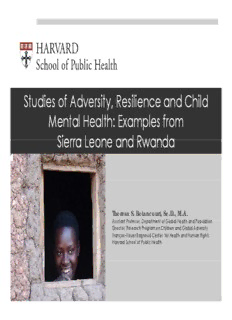
Studies of Adversity Resilience and Child Studies of Adversity, Resilience and Child Mental Health PDF
Preview Studies of Adversity Resilience and Child Studies of Adversity, Resilience and Child Mental Health
SSSSttttuuuuddddiiiieeeessss ooooffff AAAAddddvvvveeeerrrrssssiiiittttyyyy,, RRRReeeessssiiiilllliiiieeeennnncccceeee aaaannnndddd CCCChhhhiiiilllldddd MMeennttaall HHeeaalltthh:: EExxaammpplleess ffrroomm SSSSiiiieeeerrrrrrrraaaa LLLLeeeeoooonnnneeee aaaannnndddd RRRRwwwwaaaannnnddddaaaa Theresa S. Betancourt, Sc.D., M.A. AAssssiissttaanntt PPrrooffeessssoorr, DDeeppaarrttmmeenntt ooff GGlloobbaall HHeeaalltthh aanndd PPooppuullaattiioonn Director, Research Program on Children and Global Adversity François-Xavier Bagnoud Center for Health and Human Rights Harvard School of Public Health OOvveerrvviieeww (cid:134)(cid:134) BBackkgroundd: researchh on chhiillddren, ffamiilliies andd adversity (cid:134)(cid:134) GGuiiddiing fframeworkks (cid:134) Longitudinal Study of War-Affected Youth in SSiieerrrraa LLeeoonnee (cid:134) Mental health risks and processes of resilience in RRwwaannddaann cchhiillddrreenn aanndd ffaammiilliieess aaffffeecctteedd bbyy HHIIVV (cid:134) Implications for programming and policy The Nature of War is changgingg with devastating consequences for Civilians □ Worldwide, over 1 billion children live in countries affected by armed conflict (UNICEF, 2008) □ IIncreases iin regiionall andd iinttra-nattiionall confflliictts □ non-state actors □□ lliittttllee rreeggaarrdd ffoorr iinntteerrnnaattiioonnaall ccoonnvveennttiioonnss □ Civilians, particularly young people, are often the most vulnerable □ Wars of destabilization; infrastructure is undermined □ Impplications for survival,, but also trajjectoryy of development Refugee Children and Adolescents in the US □ Resettlement of ~3 million refugees in the US since 1973, roughly half are children (Bureau of Population Refugees & Migration, 2010) □ Refugees and asylees face stress of isolation, socioeconomic disadvantage, cultural adjustment language barriers, insecurity of legal status □□ HHiigghh lleevveellss ooff wwaarr-rreellaatteedd ttrraauummaa ddooccuummeenntteedd ffoorr refugee youth, with profound MH consequences (American Psychological Association, 2010). □ Challenges in treatment engagement and retention, very little services research Research on Children, WWar && MMenttall HHealltthh Children and War (Fred & Burlingham, 1943) (cid:137) Research on adults: (cid:131) “concentration camp syndrome” (Eitinger, 1961) (cid:131)(cid:131) wwaarr vveetteerraannss “sshheellll sshhoocckk” ((WWWW II, IIII, VViieettnnaamm)) (cid:137) Focus on relationship between war-related trauma and ppoosstt-ttrraauummaattiicc ssttrreessss ddiissoorrddeerr ((PPTTSSDD)) (cid:131) Cambodian refugees: 50% developed PTSD (Kinzie, 1985) (cid:131) Bosnian refugees: 25% PTSD and 17% depression dx (Weine, 1995) (cid:137) Criticism of PTSD focus- CONTEXT: There is no “post” …in many of the wars children face around the world insecurity is constant - AAvaiillabblle researchh iis lliimiittedd iin iitts applliicattiion tto programs andd policy Resilience: “A construct representing ppoossiittiivvee aaddaappttaattiioonn ddeessppiittee aaddvveerrssiittyy”” (Luthar, Cicchetti & Becker, 2001) HHxx ooff RReessiilliieennccee RReesseeaarrcchh (cid:137)Peopple who overcame situations normallyy associated with poor mental health and developmental outcomes (cid:137)Poverty, Socioeconomic Disadvantage ((Werner)) (cid:137)Mentally Ill Caregivers (Rutter) (cid:137)Abused and Neglected Children (Cicchetti) (cid:137)(cid:137)CChhiillddrreenn EExxppoosseedd ttoo VViioolleennccee ((GGaarrbbaarriinnoo)) RReessiilliieennccee RReessiilliieennccee ttrraaiittss:: ttrraaddiittiioonnaallllyy rreeffeerr ttoo characteristics of the individual that helpps them to achieve desirable emotional and social functioning despite exposure to considerable aaddvveerrssiittyy. Resilience as a pprocess: “Resilient mental health outcomes” - ((MMaasstteenn,, 11999911;; CCiicccchheettttii && GGaarrmmeezzyy,, 11999933;; RRuutttteerr,, 11998855. MMaasstteenn && Garmezy, 1985; Werner & Smith, 1992; Luthar, 1996). SSttrreessss-AAddjjuussttmmeenntt PPaarraaddiiggmm (Lazarus & Folkman, 1984) Resources SS t r •Individual Characteristics e -i.e. coping skills Mental s •Familyy Characteristics HHeeaalltthh ss -i.e.social support Adjustment o •Community Characteristics r -i.e. belonging/ s ccoonnnneecctteeddnneessss Research Program on Children and Global Adversity (RPCGA): Goals □ Identify factors contributing to risk and resilience in cchhiillddrreenn, ffaammiilliieess aanndd ccoommmmuunniittiieess ffaacciinngg aaddvveerrssiittyy globally □ focus on capacities, not just deficits □ Contribute to an evidence base on intervention ssttrraatteeggiieess:: □ Contribute to closing the implementation gap □ Develop and test high quality and effective services
Description: